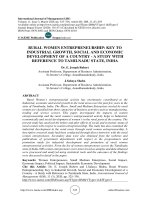Economic growth and economic development 359
Bạn đang xem bản rút gọn của tài liệu. Xem và tải ngay bản đầy đủ của tài liệu tại đây (144.45 KB, 1 trang )
Introduction to Modern Economic Growth
7.5. Discounted Infinite-Horizon Optimal Control
Part of the difficulty, especially regarding the absence of a transversality condition, comes from the fact that we did not impose enough structure on the functions
f and g. As discussed above, our interest is with the growth models where the utility
is discounted exponentially. Consequently, economically interesting problems often
take the following more specific form:
Z ∞
exp (−ρt) f (x (t) , y (t)) dt with ρ > 0,
(7.46)
max W (x (t) , y (t)) ≡
x(t),y(t)
0
subject to
(7.47)
x˙ (t) = g (x (t) , y (t)) ,
and
(7.48)
y (t) ∈ R for all t, x (0) = x0 and lim x (t) ≥ x1 .
t→∞
Notice that throughout we assume ρ > 0, so that there is indeed discounting.
The special feature of this problem is that the objective function, f , depends on
time only through exponential discounting, while the constraint equation, g, is not
a function of time directly. The Hamiltonian in this case would be:
H (t, x (t) , y (t) , λ (t)) = exp (−ρt) f (x (t) , y (t)) + λ (t) g (x (t) , y (t))
= exp (−ρt) [f (x (t) , y (t)) + µ (t) g (x (t) , y (t))] ,
where the second line defines
µ (t) ≡ exp (ρt) λ (t) .
(7.49)
This equation makes it clear that the Hamiltonian depends on time explicitly only
through the exp (−ρt) term.
In fact, in this case, rather than working with the standard Hamiltonian, we can
work with the current-value Hamiltonian, defined as
(7.50)
ˆ (x (t) , y (t) , µ (t)) ≡ f (x (t) , y (t)) + µ (t) g (x (t) , y (t))
H
which is “autonomous” in the sense that it does not directly depend on time.
The following result establishes the necessity of a stronger transversality condition under some additional assumptions, which are typically met in economic
applications. In preparation for this result, let us refer to the functions f (x, y) and
345









